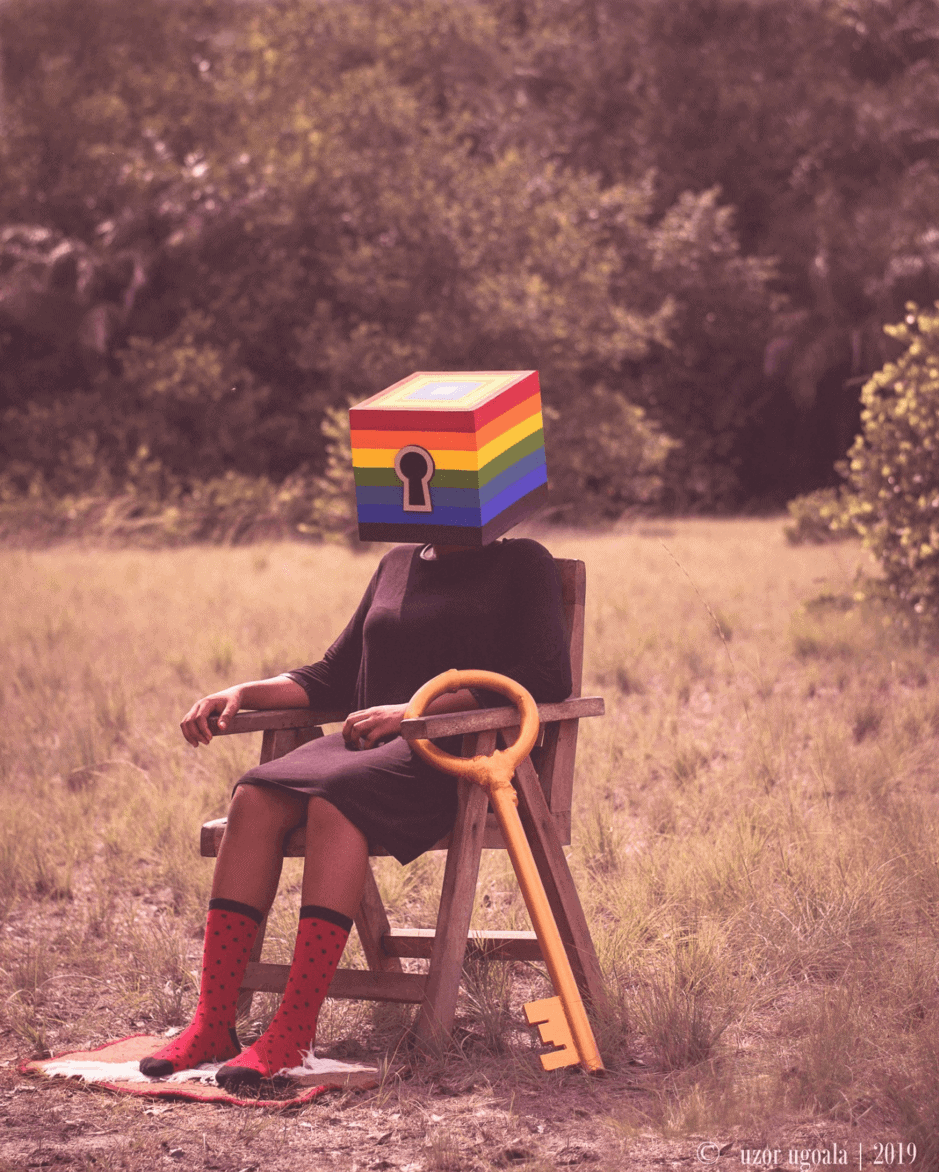THE VOICE IS THE INSTRUMENT
FORMER LARK VOCALIST INGE BECKMANN IS CAPE TOWN’S REIGNING QUEEN OF KOOKY COOL. GIDEON UNKELESS DISCUSSES HER “MOTHER-BITCH SOPRANO” OVER TEA AND SANDWICHES.
I’m at the Assembly in District Six. Inge Beckmann Live has just taken the stage. Beckmann is something out of a Tim Burton movie: morbidly stunning, vintage, and weird. Flanked on either side by a large bassist in leather pants and a nofrills accordion/trumpet player, Beckmann sits on a drummer’s throne behind a Roland keyboard. All three are dressed in black. Just in front of the keyboard is a small table overcrowded with spooky things – candles, crystal ball, skull – on a draped red cloth. The lights dim, shadows stretch, and you’re introduced to a repertoire of haunting and impeccably hit notes.
I haven’t made up a single thing and if it sounds like theatre notes, it’s because Inge Beckmann Live is as much a performance as it is a gig right now. But after a charming intro piece which sounds like a sinister stage singer warming up, you can tell that Beckmann means business. With the backing musicians setting the mood, the band is an unambitious one, but that allows Beckmann to showcase her vocal skills, which range from bluesy to a veritable cackle. At the piano, her limited skill there forces greater concentration and the result is a subdued but still spunky performance. The other version has Beckmann gnarled up behind an upright mic, winding an alabaster arm around it like a vine. Occasionally she stomps around like a vigorous pirate or a woman giving birth vertically: “it’s fun. With her talent and taste for the eclectic, it seems Beckmann is on the cusp of adding something fresh to the South African soundscape. I met her for high tea and cucumber wedges at the Mount Nelson Hotel to discuss her burgeoning new solo career.
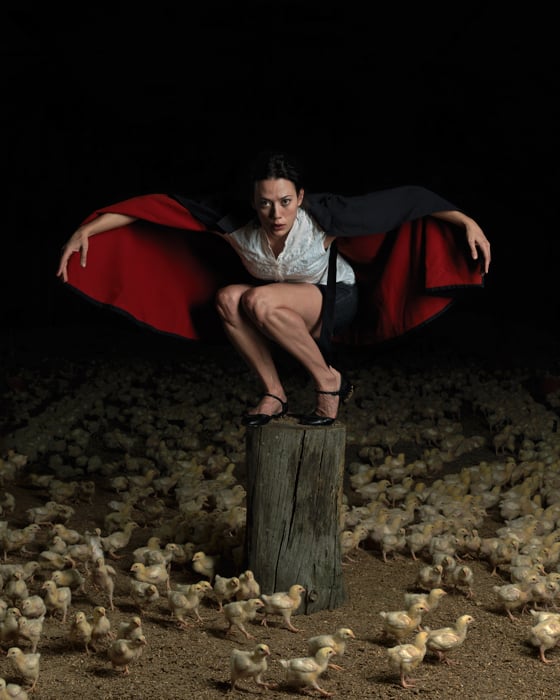
This interview could make or break your career. Are you ready?
I will break you with my bionic arm!
You’re older than the average Bright Young Thing, and then there’s your previous stint with Lark. Introduce us to Inge Beckmann.
When I was a child I enjoyed mimicking voices: male, female, old, and young ones. I also used to howl with my dog and sing into fans really high. And do the ‘creaking door’ vocal exercise. So you could say I’m self-trained. I use my voice to make melodies that are parts French noir, vampire, hip-hop attitude and opera flair. On my Myspace profile I say my style is “Graveyard Cabaret/HypNOIRtica/Classical hip hop metal slave hillbilly music”. But I hate boxes even though when I was three I enjoyed climbing inside them. Inge Beckmann Live is a three-piece band with me and a bassplayer and an accordion/trumpet player. On my own I have collaborated with Scratch from the Roots, Notembi, Queen of Ndebele, and Markus Wormstorm from Real Estate Agents. So I’m into a lot of stuff.
You don’t fit easily into categories.
I consciously try not to. My music is very visual and I actually try to paint what I’m seeing; paint frames with my voice and piano, or whatever I have at hand. I want each song or project to serve a momentary purpose. I want every bite to have a different taste. I’m also into making music for film and theatre. I’ve got ideas and luckily I’ve been able to give these ideas shape through singing and other creative outlets.
You’ve got mega range in both pitch and style too. How’s that?
I started singing in primary school. I did duets with my music teacher, Helicia Groenewald. It was fun and we sang at weekend lunches and gatherings. She sang mezzo-soprano and I did the mother-bitch soprano. In high school I turned my focus to dancing. After high school I discovered jazz through a friend’s mother. She had a whole collection of the jazz mamas: Ella, Bessie, Billie, Lena Horne and so on. I used to study Fitzgerald’s scatting for hours on repeat. After that I tried to incorporate it into my kind of operatic style and got this hybrid thing that I thought was rad. I used it in a hiphop ensemble I was in back then.
Under what conditions do you make music? Where do you start and what are the steps?
I write and sing when I want to. I have many visions and dreams and I write them down. I record my raw ideas and work on them over a few days. Sometimes a really fun idea will obsess me immediately. Other times I leave them for a few months or even years to sit in a sort of ideas tank. Most times I just make the music to entertain myself and never share it with the rest of the world. I like that in a way. It is as if they never become known to the world but the energy is still released into the universe. They never get appreciated or criticised or rated but still serve a purpose. I could get depressed about not ‘achieving’ certain things at my age because the world is a membership club filled with desperate people seeking constant recognition and remuneration. But I seek fulfilment – I am selfish like that.
Songs like ‘Polar Bear’ and ‘Serenity’ are perhaps a bit silly, even angsty. Or maybe it’s the backing tracks that give the performance a kind of David Lynch karaoke vibe…
I am somewhat of a chameleon with my solo work. The purpose is not to join and do a genre of music but rather to make beautiful noise. It’s tough music to market though and make sense of in a way, and I understand that. The media tries to tell you what to do with your hair, what to wear, how much to weigh, how to perform, and what to sing. This is very sad. It is like telling a river how deep it should be. Fuck that. As for the backing tracks, yes, at times it’s too pressured with the tracks and I feel that if I swallow a fly I’ll miss the chorus. I want to put a set together that is even more simple. Just voice and one other instrument perhaps.
I want to quote your song, ‘I’m Human’: “I am Af-ri-can. If you look past the colour of, my pig-men-tary, yes I jumped ship 17th centu-r(ar)-y, But that’s not really relevant, not really.” Does being South African factor into your music?
I am South African but I don’t make traditional South African music. I think the domestic music industry is retarded by their copycat mentality. There are a lot of artists who copy famous international bands and make generic but often watered down ‘covers’ of what has been proven to sell. I would rather our artists, audiences, and investors display courage and make South Africa a hub of musical sincerity and integrity, with a quiet arrogance for being unique. However, there are a lot of things that need changing for that to happen: better live venues, better sound, better sponsorship, better management, better marketing. We are already at the top of our game with so many things why not also jack-up the music industry?
About Inge Beckmann: Cape Town-born Beckmann (1977) started singing at the age of 4. Accomplished across a range of styles – classical, jazz, hip hop, alternative – she is a past member of the hip hop collective The Spindle Sect and indie-kid favourite Lark. She is due to release an extended play under her latest moniker, the self-styled Inge Beckmann Live. Music aside, Beckmann appears in Orgie, a 10 minute pilot promo for a South African feature film adaptation of André P Brink’s 1965 novel. The frantically paced short film is set in present day South Africa against the backdrop of Cape Town’s arts scene. (Available to view on http://facebook.com/video).
DANCING ON THE VOLCANO
STICKY ANTLERS ARE A PRETORIA QUARTET WHOSE TRANCE-LIKE MUSIC CONJURES IMAGES OF HOODED PEOPLE WALKING IN A LONG PROCESSION, STOMPING THEIR FEET, SUCCUMBING TO AN OVERPOWERING PAGAN NOISE. BY FRED DE VRIES.
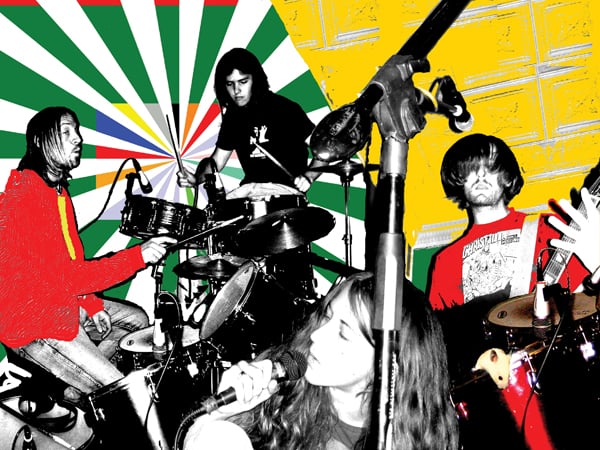
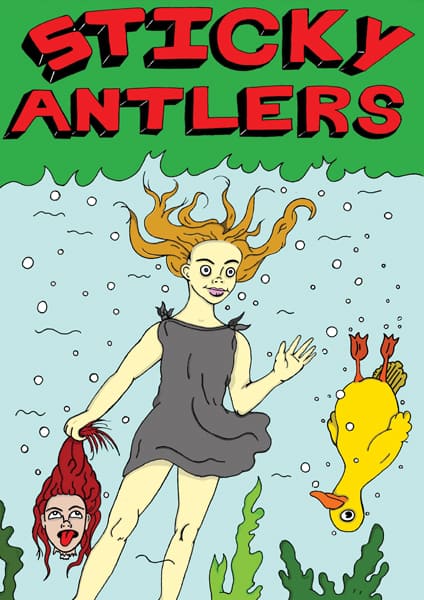 top – bottom Sticky Antlers promo graphic; Sticky Antlers
top – bottom Sticky Antlers promo graphic; Sticky Antlersband graphic. Courtesy Sticky Antlers.
One of the reasons why the late 1970s and early 80s were such a fruitful period for what we now call “indie music” is that there was nothing to do. A recession hit Europe, New York was bankrupt, and unemployment was rife everywhere. It wasn’t a slacker case of “here we are now, entertain us”; rather it was a defiant cry of “no one does it for us, so let’s do it ourselves”.
Survival lay in acknowledging the beauty of decline. Empty factories, burnt out tenements, derelict neighbourhoods, rusting shipyards: everything had its own romantic appeal. Consumer society was imploding, which gave a group of artists and musicians an almost euphoric feeling of dancing on the volcano.
One of the easiest artistic ways to digest and reflect what was going on in society was to form a band. Punk had taught that all you needed were two chords and some words. Next it came down to recording your songs, designing your sleeves, printing them, folding them and then distributing your record. The basic premise was: be a hero, create your own mythology and escape the drudgery of everyday life. Some of the more memorable bands born of this
DIY ethos were Gang of Four, Wire, Einstürzende Neubauten, DAF, Sonic Youth and, locally, Koos, whose line-up included actor Marcel van Heerden and conceptualist artist Neil Goedhals.
As so often happens, history is repeating itself. A global economic meltdown is causing widespread panic. The music industry is in an almost deeper crisis, with mp3s, file sharing and blogs making the overpriced CD all but obsolete. Music stores and live venues are closing one by one. A new generation cries out: “here we are now, but where’s the entertainment?” So with a nod to those fertile late 1970s, Pretoria-based musicians/artists/partners Andreas Schonfeldt and Martinique Pelser decided that DIY was the answer. They transformed their home into a studio, a practice room and a meeting place for likeminded people, all cantered on the idea of making decidedly anticommercial music. The soundtrack in the house is an eclectic mix of noise, Krautrock, hip-hop and stripped down ballads.
Pelser and Schonfeldt are two longhaired oddball twenty-somethings who met each other seven years ago through mutual friends. “I liked him, but we were a bit shy,” recalls Pelser. “So we didn’t talk for about a year. Finally I had the guts to ask him if he wanted to make music together. We’ve been playing since forever.”
They started out as a duo, calling themselves Ecto Kid & Plasma Girl, evolving into Poodlepiss, which eventually became Sticky Antlers after they found fellow conspirators in Jaco Wolmeraans and Damon Civin, the drummer and guitarist respectively, neither of whom had any experience with drum sticks or a plectrum.
So getting a band together wasn’t all that hard. Nor was printing the flyers and posters, Sticky Antlers’ graphic output recalling the illustrative style of Raymond Pettibon yet exemplary of a recent vogue for degraded illustrations. Then it came down to starting a record label. In December 2007 Pelser and Schonfeldt created the KRNGY label, named after a phrase used in animation. Over the course of the next year KRNGY released 19 albums, mostly as home burnt CD-Rs, by local bands such as Suicycle, Unicorn Rizla, Revenge Radio and the wickedly named If You Are What You Eat Then I Could Be You By Tomorrow.
“We try to give the other bands a hand and put them on our label and sell their CDs at our shows and pass them on to people who might be interested,” says Pelser about the Pretoria underground that they have excavated. “We like to give a hand, but we’re music snobs, we won’t sign something we don’t like.”
So far KRNGY have released only one proper, factory produced CD, a selftitled album packaged in an exquisite, handmade cover. Musical references are diverse: PJ Harvey, Sonic Youth and The Boredoms; theirs is a sound that elides noise, drone and song. Distorted and haunting, this sound can occasionally verge on the hysterical. It has a trance-like, tribal, motorik quality to it, which conjures images of hooded people walking in a long procession, stomping their feet, succumbing to an overpowering pagan noise.
“We record at home, where we have a 4-track recorder, computers and tape decks. We also record on old video cameras, anything we can find to magnetically store something,” says Pelser about the heavy distortion that works as a fifth band member.
Like little scared animals they have come out of the woodworks, forging links with other likeminded folks: Paul Riekert’s One-F Records in Jo’burg, Righard Kapp and Buckfever Underground in Cape Town, and journalist Lloyd Gedye who invited them for the third issue of his Pavement Special CD and concert.
A scene? Pelser smiles warily. “We’re all tiny centres, somehow connected.”
Fred De Vries is a journalist and author of the book Club Risiko (2006), an account of the European underground music scene of the 1980s.
About Sticky Antlers: Formed in 2006 by Andreas Schonfeldt, Martinique Pelser and a third party known only as J-H-C, the band initially performed under the stage name Poodlepiss. After J-H-C’s departure the group reinvented itself as Sticky Abtlers and played their first shows at Cafe Arc, in 2007. In December 2008, the band was invited to play at the launch of the third issue of Pavement Special, a music magazine edited by journalist Lloyd Gedye and designed by artist Michael MacGarry. The event was held at Arts on Main. Sticky Antlers describe their sound as “noise/ improv/ experimental/ indie kewlness”.
WHEN THE BOWL BREAKS… THE AUDIENCE IS SHOCKED
“MY TOOLS ARE SCALE AND SPACE,” BRONWYN LACE HAS SAID OF HER PRACTICE. ROBYN SASSEN MET WITH THIS JOHANNESBURG ARTIST TO TALK ABOUT MATHS AND GOLDFISH.
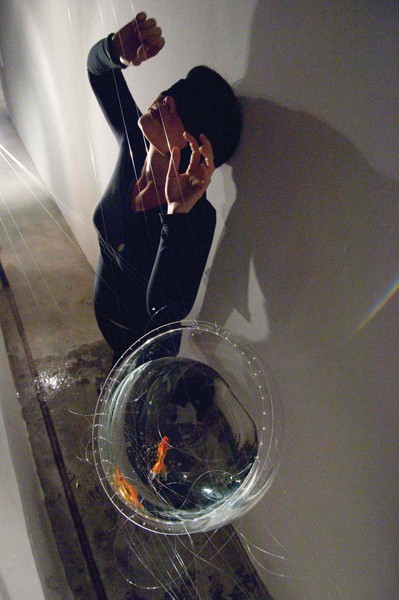
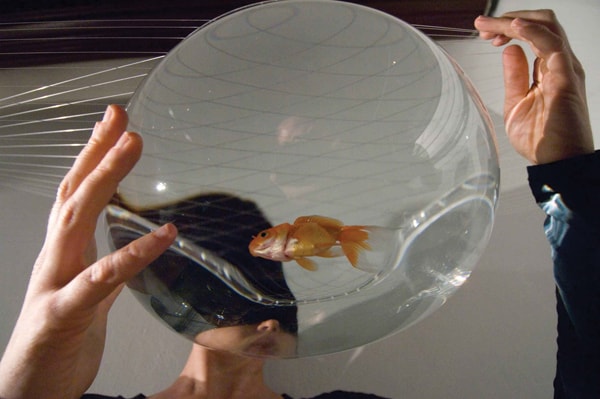
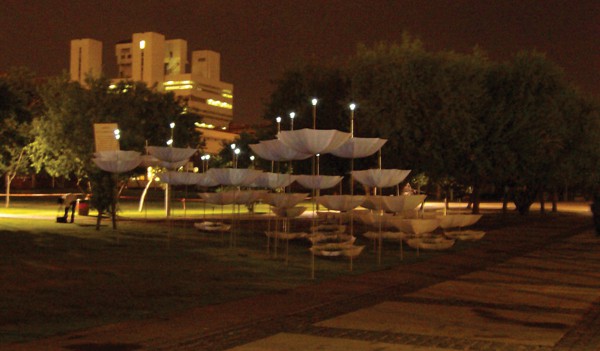 clockwise from top left Bronwyn Lace, Justified Detachment, performance at Art Extra, March 2008, installation materials: fishing line, perspex, bowl,
clockwise from top left Bronwyn Lace, Justified Detachment, performance at Art Extra, March 2008, installation materials: fishing line, perspex, bowl,goldfish and water; Bronwyn Lace, Justified Detachment, performance at Art Extra, March 2008, installation materials: fishing line, perspex, bowl,
goldfish and water. Performance photos John Hodgkiss; Bronwyn Lace, Negentrophy, 2008, site-specific installation commissioned by Johannesburg
Development Agency for festival When Life Happens held in December 2008.
She hasn’t studied mathematics, not formally, cannot read music and doesn’t have a religion, but Bronwyn Lace creates work that flirts with and skirts around the precious values informing these disciplines. She calls her work “performed installations” and is profoundly seduced by beauty. The Golden Mean, the Phi spiral and the Fibonacci sequence are amongst her tools for creating her ultimately ephemeral work.
A co-instigator of the SA Arts Emerging website, together with Nathaniel Stern, Simon Gush and Rat Western, Lace is interested in proactivity. From 2005, this project has provided a platform for artists sidelined by the art world because of their “emerging status”.
“When I was a student, I looked to the Trinity Session as though they were the avant-garde,” she says. “I have since learnt that current students look at SA Arts Emerging with similar inspiration.” It wouldn’t be fair to call Lace’s aesthetic “conceptual”, though it engages with
the mathematical sciences. “Ideas are allowed to grow in my head for a long time. The logistics determining how the work will look is my challenge.”
So how about performance artist? “I never envisioned myself as a performance artist,” she responds. “In 2007, it became apparent: performance was forcing itself into my installations.” This was the cornerstone of Justified Detachment, a work initially performed in 2007, at the Bag Factory, but exhibited photographically a year later at Art Extra (now Brodie/Stevenson), as part of the group show Aftermath. “David Brodie was the first commercial gallerist to notice me.”
Lace describes the trite and emotional reactions of audiences to an early version of Justified Detachment, which featured a goldfish as its central protagonist. “They asked me if I thought the fish was lonely. I had to murder it, to push the work in a new direction”.
An outcome of her participating on a workshop led by John Thom, Lace admits that the performance medium was scary. “I blindfolded myself, which also seemed to justify my actions.” The goldfish was placed in a Perspex bowl, with holes drilled around its rim and was attached to a web of fish gut. Lace’s role in the work was to gradually break the threads holding the fishbowl in this web, with her teeth, eventually causing it to smash to the ground, and the fish to die. “When the bowl breaks and the fish falls, the audience is shocked,” she explains. “This is understood as the dramatic climax of the piece. It’s interesting, because it’s so predictable from the outset that the fish will die in this manner. It’s like life. People get shocked even though the end of a situation is so obvious.”
I ask her what the work is attempting to communicate.
“It might be about death, but it’s also about the beauty of mathematics. I believe beauty is the ultimate seducer and can change how one thinks. Maths and science inform our realities and surpass religion. Science is filled with beautiful metaphors. For instance, there is talk of unpredictable particles next to other atoms. It’s a way of understanding that life happens when least you expect it, and that aberrations in routine affect who we are.”
While she was a student, Lace’s friends were studying engineering. “Our conversations led me onto other paths. There was always a sense of intimidation, an understanding that those doing professional science degrees were wiser, that they could understand things I couldn’t. In truth, they were unable to see the relevance of discovering the bigger picture.”
Her work is labour intensive, to the point of being irrational.
“Irrational was a piece I constructed at Outlet in 2006, actually. In this work, I created 4000 origami cranes which fit into one another, working logically into a spiral, but then into a state of chaos and back again. It’s about order amid chaos and vice versa.”
Lace has just returned from a kite-flying project in Sutherland, where she worked collaboratively with astronomers and children. Collaborative, socially aware projects have always been part of her agenda, Lace participating in an HIV/ Aids festival last December, her work Negentrophy involving upside down umbrellas as vessels of containment. Next on her agenda is an exhibition at the Durban Art Gallery, with Vaughn Sadie. It will include “hundreds of clock mechanisms and fishing flies,” she says. It’s about time.
Robyn Sassen is Arts Editor of the SA Jewish Report.
About Bronwyn Lace: Born in Francistown, Botswana (1980), Johannesburg-based Lace completed her BA (FA) at Wits University in 2004. A co-founder of the website www.saartsemerging. org, she freelances as an academic, an assistant curator and operates as the Educational Officer for the Bag Factory in Newtown, where she runs an educational exhibition programme. Since 2002, she has exhibited her work in a variety of experimental venues, notably on 8/5 (i) at Simon Gush’s Parking Gallery (now defunct) in 2006 and 8/5 (ii) at the Bag Factory in 2007.
LOOKING BACK AT MYSELF
ERITREAN NATIONALS NEED TO HAVE A PASS AND A FIXED REASON TO TRAVEL WITHIN THEIR OWN COUNTRY. ERITREAN EXPATRIATE DAWIT L. PETROS TELLS NADINE RUBIN HOW HIS OTHERNESS ALLOWED HIM MOBILITY TO CREATE HIS NEW WORK.
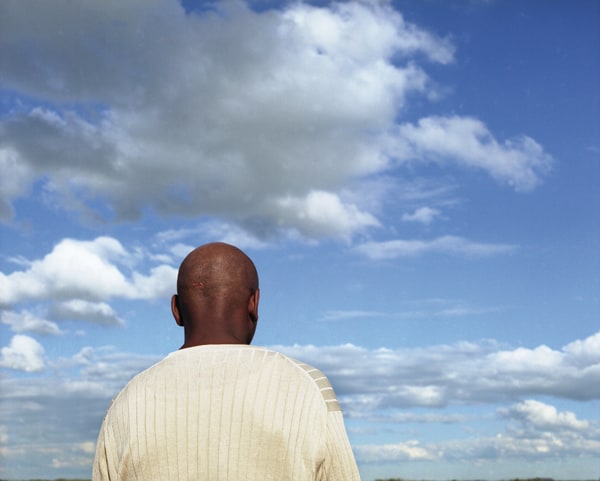
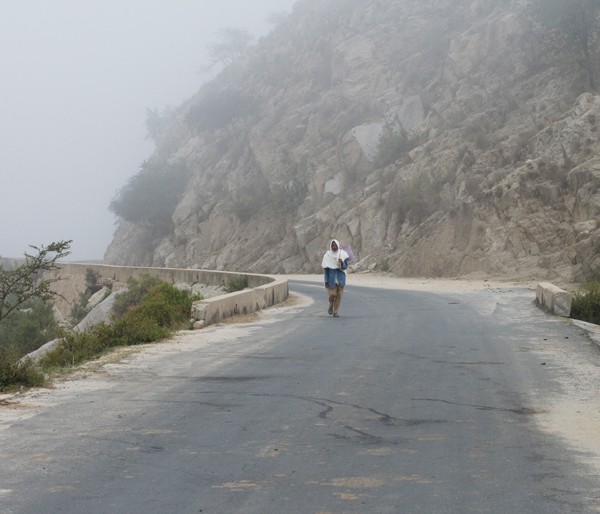 top – bottom Dawit L. Petros, Matthios, 2005, C-Print, 76.2 x 101.6cm;
top – bottom Dawit L. Petros, Matthios, 2005, C-Print, 76.2 x 101.6cm;Dawit L. Petros, Untitled (Confluence II), Dekemhare, Eritrea, 2008,
C-Print, 50.8 x 61cm.
One Saturday morning last November a small crowd had gathered on the tenth floor of a building in Chelsea, New York, to hear Dawit L. Petros talk about A Total Instance of Reflexivity, his first New York solo outing. At Alexander Gray and Associates, Petros had installed a set of six shiny black boxes arranged in grids of multiple sizes. Behind the darkened Plexiglas were photographs of two distinct but unidentifiable landscapes and a double self-portrait taken from behind. Gray called them “darkboxes” and, noting their architectural presence, described them as a reversal of Jeff Wall’s lightboxes.
To make the work, Petros researched how black mirrors have historically been used in art. One mirror used by artists in the 19th century caught his attention. “People would go into a vast vista with a small, hand-held, convex mirror. When they stood with their back to the landscape and held up the black glass, the landscape was reflected in it. I was intrigued by the idea that this seeming vastness was considered on this tiny surface,” says Petros, who sports a goatee and is noted for his impeccable dress sense. The idea that one didn’t face what one looked at, but rather that one faced the landscape through this tool became the metaphor for Petros to think about the relationship of those living in the diaspora to one’s own history.
Born in Asmara in 1972, he spent just eight months the Eritrean capital. At that time the tiny East African country was still embroiled in the decades-long war with its neighbour, Ethiopia, and there was an exodus of Eritreans streaming over the border into Sudan or, like the Petros family, making their way through Ethiopia and down to Kenya in the south. Petros spent most of the first decade of his life as a refugee in Nairobi. Eventually, his family, sponsored by a group of Menonite doctors, moved to Saskatchewan, Canada. As an adult he has lived in Montreal, Boston, California and now multi-cultural Brooklyn. Inspired by the strict parameters set by artists like Adrian Piper, Vito Acconci, and Sol LeWitt, Petros uses photography, video and installation to construct and deconstruct his peripatetic existence and the experience of living in various diaspora. Petros’ scholarly rigor resonates in his work but “it’s his use of personal history within a theoretical framework that pushes it past being purely academic or impressionistic,” says Gray. “There is such heartfelt, raw emotion there.”
To try to establish his relationship to Nairobi, Petros returned for the first time in February 2007 and drove about 45-50 minutes south to Naivasha.
“I stood at a point where I could see over the Rift valley, looking north towards Eritrea and made a photograph,” he says of the landscape that is framed inside one of the black boxes. As you approach it, Petros’ photograph appears, apparition-like through the smoky Plexiglas. The landscape could be anywhere and because of the shiny surface, you come face to face with your own reflection too – a meditation on the universal relationship between people and the places that hold meaning for them. You, as the subject, are literally forced to navigate the space. But as you begin to move around, the image falls into a sea of black and you learn that, like the fragment of a memory, the information that brought you in is unstable. “Memory functions very specifically to the diasporic subject,” explains Petros. “It’s contingent, it’s flexible and it’s always in the process of being renegotiated relative to experiences in a new location.”
Petros’ parents made sure that he and his three brothers retained a strong rootedness in their own culture and taught them to speak Tigrinya. “They believed that if you forget your connection to what makes you who you are you are completely displaced,” he says. As an adult, Petros realised his indebted to these Tigrinya lessons. The first time he returned to Eritrea in 1998, they enabled him to converse with his aging grandmother. When he returned last February, determined to “seal the gesture” that he had begun in Nairobi in 2007 and take a second photograph looking south from Eritrea towards Kenya, they saved his life.
“I thought it would be a simple thing to find a point on the western face of the Rift Valley and take a photograph,” he says. “But I arrived to find a different country to the one I had visited a decade earlier.” Eritrean nationals need to have a pass and a fixed reason to travel within their own country. Failing to do so could mean detention. And within this tense, environment, the simple act of taking a photograph became political. Every time he took out his medium format camera he and his cousins were arrested and his film confiscated. Soon after, he was let go, but his cousins weren’t so lucky.
“A part of what ensured my safety there was that it was obvious that I grew up overseas. Being ‘other’ in that regard is what allowed me to move around,” says Petros, still visibly disturbed by the experience. He finally captured the image digitally because the digital cards, he learned, meant nothing to most of the soldiers. “Non-familiarity became the very thing that made it possible for me to make the work.” There is no clue in Petros’ beautiful landscapes to suggest the tension in which they were made. He shakes his head. “Part of my fear as an artist is that I am making something way too aesthetically pleasing when it contains such a difficult group of issues.”
Nadine Rubin is a New York-based writer currently completing her Masters degree in arts and culture journalism at Columbia University.
About Dawit L. Petros: Born in Asmara, Eritrea (1972), New York-based Petros completed his undergraduate studies in Montreal then relocated to Boston where he earned a MFA at the School of the Museum of Fine Arts. His photographic practice has evolved from straight documentary portraiture, notably a series of portraits of North American-Eritreans, to encompass aspects of conceptual photography and performance art. Widely exhibited internationally, he has presented three solo exhibitions, most recently a self-titled one-person show at Alexander Gray Associates, New York. The recipient of numerous awards and grants, he was a 2008 artist-in-residence at the Studio Museum in Harlem, New York.
